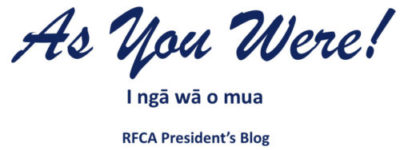
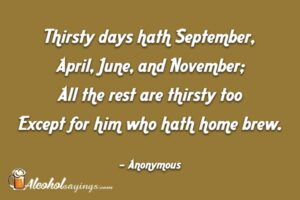 Greetings fellow Clubbies. If you know the original of this verse and you were a calendar-watcher like me, you knew that we were now two-thirds of the way through our Cadet year and that counting down the days to Grad had become a major daily task.
Greetings fellow Clubbies. If you know the original of this verse and you were a calendar-watcher like me, you knew that we were now two-thirds of the way through our Cadet year and that counting down the days to Grad had become a major daily task.
Speaking of home brew, when I was searching for an image to go with the September theme for this post, I found that most came from the northern hemisphere and were about things to do with autumn, not spring, e.g., those from the U.S.A had lots of pumpkins in them.
This reminded me of the pumpkin wine that the cooks set up in the ceiling cavity in Maleme Barracks (until it frothed over and the ceiling panels and adjacent walls took on a decidedly orange colour – when all hell broke loose!).
I thought then about alcohol in general when we were Cadets and the various rules surrounding it. Here is another “prohibition” poem from my memoir about that:
"Prohibition 4.0 – Alcohol"
- Thou shalt not hide nor drink alcohol in the barracks.
- Thou shalt not hide nor drink alcohol on Tank Hill or Gory Green.
- Thou shalt not hide nor drink alcohol in the housing area.
- Thou shalt not distill alcohol in the barracks ablution block ceiling cavity– it will explode and stain the panels an orange pumpkin colour.
- Thou shalt not dig tunnels from the barracks to the WOs and Sgts’ Mess bulk liquor store.
- Thou shalt not borrow the bolt cutter from the Fire Station and cut the padlock on the door of the WOs and Sgts’ Mess bulk liquor store and filch its contents.
- Thou shalt not drink alcohol under the trees in the Taihape Domain when on Friday night local leave.
- Thou shalt not adulterate the spirits in the liquor cabinet if we fail to leave you a bottle of beer when you are baby-sitting.
- Thou shalt listen very carefully on away sports trips when told what pub the RF staff will be drinking at.
Tribute – One of our own
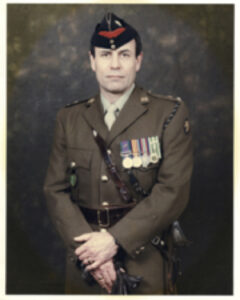 Colonel Craig A Cocker, OBE, MID, Royal Anglian Regiment, Crump Class
Colonel Craig A Cocker, OBE, MID, Royal Anglian Regiment, Crump Class
The New Zealand Army Bit
Craig joined the Regular Force Cadets as a member of Crump Class. He is (so far) the last Cocker to have alighted onto the old windswept Waiouru railway station sometime during the dark hours of January 1967. Preceding him were two of his uncles: WO1 Joe Cocker RNZIR, ex-27 Machine Gun Battalion 2 NZEF and one-time RSM Army Schools and the formidable but acid-tongued WO1 Jack Cocker MBE, RNZIR, also ex-27 Machine Gun Battalion, and one-time RSM ATG and SWI 1 RNZIR. They were followed by the equally impressive WO1 Mike Cocker, RNZIR/NZSAS, Bennett Class, Craig’s older brother. As you will see it was a martial lineage that was to be enhanced by Craig too and in no small degree over the coming 38 years.
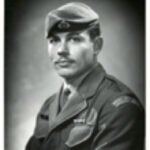 While at school Craig had been offered a ROSB for selection to RMC Duntroon but he elected not to take up the offer at that time. He graduated at the end of the year having qualified on the Instructors Course and was again offered a ROSB. As a result Craig was posted to OCTU with the intention of entering Portsea in January 1969. However, he decided to delay officer training. Mike had already been on Active Service in Borneo and Vietnam, and Craig was keen to do some real soldiering first. Officer training could wait. He was posted to 1 RNZIR in Terendak, Malaysia in preparation for a year’s tour to Vietnam with Whiskey 3 Company and deployed in November 69 as a section 2IC.
While at school Craig had been offered a ROSB for selection to RMC Duntroon but he elected not to take up the offer at that time. He graduated at the end of the year having qualified on the Instructors Course and was again offered a ROSB. As a result Craig was posted to OCTU with the intention of entering Portsea in January 1969. However, he decided to delay officer training. Mike had already been on Active Service in Borneo and Vietnam, and Craig was keen to do some real soldiering first. Officer training could wait. He was posted to 1 RNZIR in Terendak, Malaysia in preparation for a year’s tour to Vietnam with Whiskey 3 Company and deployed in November 69 as a section 2IC.
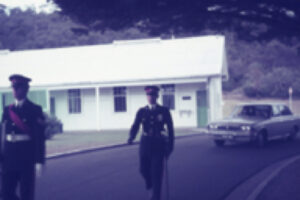 On returning from 1 RNZIR Craig was briefly posted to NSTU Waiouru before again attending OCTU in preparation for Portsea in January 1972. Craig returned from a successful year in Portsea in December 1972, not only with a commission, but with his new wife Marion.
On returning from 1 RNZIR Craig was briefly posted to NSTU Waiouru before again attending OCTU in preparation for Portsea in January 1972. Craig returned from a successful year in Portsea in December 1972, not only with a commission, but with his new wife Marion.
After brief sojourns to TF Depot, Burnham and 3 Brigade Craig arrived in 1 Battalion Depot in 1974 as the Mortar Platoon Commander, my first encounter with this clever, spirited junior officer who, because he’d been there and done that unlike most new officers, was not going to be subservient to any senior NCO. Initially our relationship was somewhat feisty, not least because I had (reluctantly) to relinquish the platoon commander role. It wasn’t long however before we had a first class platoon, led by the rightful platoon commander whose major concern was always for his soldiers and their professional competence. It was a platoon full of characters, one not least being the platoon commander, and one that was to largely remain together until May of 1977 on return from Singapore.
In May 1977 Craig was posted to the Regular Force Cadet School as the Company Commander of A Company and Training Officer. A deployment on Exercise Long Look to the British Army on the Rhine followed which clearly sowed the seeds for a major career move a few years later.
Craig was promoted captain and next posted in May 1978 as the Senior Instructor, Support Weapons Wing, School of Infantry and then in October 1979 as the Senior Instructor Tactics Wing, also at the School of Infantry.
By June 1980 the Military Secretary had caught up with him and off he went to HQ 3 Brigade for his first staff posting as Staff Officer Operations, a job he ‘surprisingly enjoyed’.
From November 1982 Craig was promoted to major and posted as a company commander to 2/1 RNZIR. It was during this period he was selected as the exchange officer at the US Army Infantry School at Fort Benning in the USA. He deployed there in June 1983. Not long after this came the tiff with the United States over our anti-nuclear policy necessitating a degree of diplomatic nous hitherto dormant in the life of Major CA Cocker. As he puts it: “It was a bit of a shock to see New Zealand relegated in one step from trusted friend and ally to down among the ‘Z’ countries with Zimbabwe and Zaire!” Eleven months at Staff College at Fort Leavenworth followed from which he graduated with honours, but not to be replaced for many years.
Brigade Major 1 Brigade was his next appointment. This posting apparently allowed him enough time to take up flying. It was during this time that Craig began investigating a transfer to the British Army. In this he was sponsored by a British liaison officer from the Royal Anglian Regiment he got to know during his time at Fort Benning. Craig accepted an offer as a company commander into a regular battalion of the Royal Anglian Regiment and transferred to the British Army in March 1988. He understood that because of age and background he was unlikely to progress beyond Major. Craig explains: “We agreed that if we were going to be in the British Army we had to embrace it without looking over our shoulders. This wasn’t a matter of turning away from my heritage or of being disloyal to the NZ Army. I’m as proud a New Zealander and Marion an Australian as anyone but we had to make a new life in a new place and it seemed to us that the best way to do that was to assimilate sensibly and quickly.” He was to thoroughly demonstrate that commitment in the coming years as you are about to read.
The British Army Bit
Craig: ‘Another piece of luck on arrival in Gibraltar. My new CO, John Sutherell, had been Noel Philp’s Squadron Commander in 22 SAS and he thought very highly of New Zealanders, so he’d asked for me to join the 1st Battalion and we got along famously from the start. More luck: Mike Jones, the Gibraltar Fortress Commander, had played rugby for England and was a great admirer of the All Blacks. Better born lucky than rich, eh?’
Craig joined the 1st Battalion, the Royal Anglian Regiment in June 1988 as a company commander destined for Crossmaglen, South Armagh in Northern Island. He came away from that tour with ‘the deepest respect and admiration for gritty, nuggetty, determined little Tommy Atkins who had taken mines, mortars, shootings and all kinds of other difficulties in his stride.’ For his efforts he was Mentioned in Despatches. While I was unable to secure a copy of his MID this report from his CO pretty much explains it:
“Major Cocker’s second year as a Company Commander has been most impressive. It has involved a unit move from Gibraltar to Colchester, forming and training a five platoon company for operations in Northern Ireland, and then running the Crossmaglen TAOR in South Armagh, arguably one of the most demanding sub-unit commands in the Army. That Major Cocker, with no previous experience of Northern Ireland, has taken this challenge totally in his stride and proved particularly effective is to give some measure of his quality as a soldier and commander.
A stocky, mature, invariably cheerful but quietly spoken and unassuming man with great reserves of common sense and calm inner strength, Major Cocker combines the sensitivity to be a shrewd judge of situations and people with the mental and moral robustness that inspires confidence and allows him, in spite of difficulties, to impose his will on a situation. The skill with which he has trained and led his young team, guiding the inexperienced, restraining the over-enthusiastic, encouraging the weak and reconciling the abrasive, has been particularly impressive. Operationally he is sound, positive and skilful, invariably thinking problems through, planning in detail and preserving tactical balance. He has not only proved remarkably resilient to the sustained pressure of commanding an isolated position under frequent threat but he has also retained a refreshingly clear comprehension of the operational context in which he has been working. This is a direct reflection of his depth of experience, wide interests and overall professional expertise.Crossmaglen is not a place to take chances, and I consider myself most fortunate to have had a man of such character and professional ability to command in this key area.
I grade Major Cocker in the top third of the EXCELLENT bracket and recommend him unequivocally for promotion. Notwithstanding his age and the fact that he is about to embark on a Grade 2 staff appointment, he clearly has the qualities to command a Regular Battalion.”
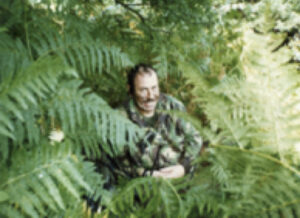 Craig’s first staff appointment in the British Army was to Germany in HQ British Army on the Rhine at Rheindahlen. That was followed in February 1992 as the Battalion 2IC, the 2nd Battalion, the Royal Anglian Regiment in Celle, also in Germany. He was selected for promotion to LtCol and later picked up on the Command List for a regular battalion. In December of 1993 Craig was promoted and posted as the CO of the Support Battalion of HQ Allied Command Europe Rapid Reaction Corps (ARRC) destined for Sarajevo, Bosnia. The Battalion’s role was to move, establish, protect and support the Corps HQ. (photo: On operations in Crossmaglen)
Craig’s first staff appointment in the British Army was to Germany in HQ British Army on the Rhine at Rheindahlen. That was followed in February 1992 as the Battalion 2IC, the 2nd Battalion, the Royal Anglian Regiment in Celle, also in Germany. He was selected for promotion to LtCol and later picked up on the Command List for a regular battalion. In December of 1993 Craig was promoted and posted as the CO of the Support Battalion of HQ Allied Command Europe Rapid Reaction Corps (ARRC) destined for Sarajevo, Bosnia. The Battalion’s role was to move, establish, protect and support the Corps HQ. (photo: On operations in Crossmaglen)
For his performance in this demanding role he was made an Officer of the Military Division of the British Empire. Again, I was unable to obtain his citation. However, this report by Craig’s Brigade Commander will more than do the job:
‘’Lieutenant Colonel Cocker commanded the Support Battalion, Headquarters ARRC for the first 6 months of Operation Firm Endeavour in Bosnia-Herzegovina, taking them through the deployment phase before building and establishing the various elements of the Headquarters in Sarajevo and Kiseljak. The complexity of the challenge was considerable and he rose to the occasion magnificently.
A professional field officer to his fingertips, Lieutenant Colonel Cocker led from the front, giving his subordinates firm and timely direction, which meant that they were always well balanced to meet any eventuality. That his Battalion was so well prepared and trained for the mission was entirely down to the efforts of Lieutenant Colonel Cocker. Every man understood his intent and the Battalion’s battle procedure was honed to a high pitch. His grasp of the tactical situation and logistics requirements in Theatre was exceptional, and he was able to deliver a grade of service which ensured that the Commander knew his Headquarters was safe and well administered at all times. He cared deeply for the welfare and morale of his men, and they knew it. Nevertheless, he ran a tight ship and the discipline that he imposed meant that his men focused on the task at hand without distraction. He proved throughout his time in Bosnia that, on operations, he was a real commander.
Lieutenant Colonel Cocker is a delightful man. Blessed with an agile mind and a marvellous sense of humour, he is always good company. During some of the darker moments of the tour, he was always able to bring a sense of reality to a confused or difficult situation, and he proved that he was a friend in a crisis. He remains remarkably fit, enjoys life to the full and ensures that those around him do likewise.
In summary, Lieutenant Colonel Cocker was an exceptional commanding officer on operations. His personal example was second to none, and his efforts have been formally recognised with award of the OBE. He had an EXCELLENT tour in command and he left behind a legacy that will be hard to follow.”
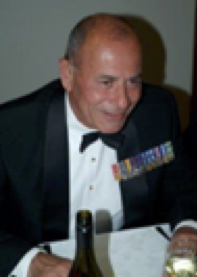 In November 1996 Craig was again in Germany with the HQ of the ARRC after his tour to Bosnia-Herzegovina. In August 1998 he was promoted to colonel into a staff appointment but still in Germany. In this role he served in Macedonia and then Kosovo. I felt quite at home in the ARRC: the motto was Audentis Fortuna Juvat – Fortune Favours the Bold’.
In November 1996 Craig was again in Germany with the HQ of the ARRC after his tour to Bosnia-Herzegovina. In August 1998 he was promoted to colonel into a staff appointment but still in Germany. In this role he served in Macedonia and then Kosovo. I felt quite at home in the ARRC: the motto was Audentis Fortuna Juvat – Fortune Favours the Bold’.
Towards the end of 2000 Craig successfully applied for a loan service job in Nigeria as the commander of an advisory team working with the Nigerian Armed Forces. He was the only applicant and as most of us who served know, a volunteer is someone who didn’t understand the question, as he unnecessarily points out. It was to this destination he arrived in January 2001. He explains further: ‘It was a fascinating posting and we made the most of the experience, a highlight of which was the visit by the Queen and Duke of Edinburgh for the 2003 CHOGM. Everyone in the High Commission and other UK staff like me were called in to support this showcase event. Marion was working for the DA and she was tasked with liaison to the Presidential Palace staff for the State dinner arrangements while I escorted Prince Philip to Lagos for a one-day visit – we had the whole 777 that the Royal party had come from UK in, to ourselves. We had a great day and he went up several more notches in my estimation’.
And the wonderful career of Colonel C A Cocker, OBE, MID was ending. Craig returned to the UK in October 2004 to retirement in March 2005 after 38 years of soldiering. He and Marion now live in Melbourne but are frequently in New Zealand as their son and daughter did not desert with them. It was great to catch up with him, albeit only fleetingly, at the 70th Reunion last year after 31 years. His was an unparalleled and hugely successful career and he was an officer with whom I was very pleased to serve.
Note. The problem I had in writing this tribute was what to leave out. Unfortunately, space dictates far too much. Craig is a raconteur with few equals in our world and I would urge him to write a book that we would all enjoy reading and owning and one that would be a lasting legacy for those who paraded (probably too often) at the R F Cadet School flagpole.
Craig A Cocker, Crump Class, has been an outstanding exemplar for we late of the Regular Force Cadet School. FORTES FORTUNA JUVAT
Bob Davies
Military Arts
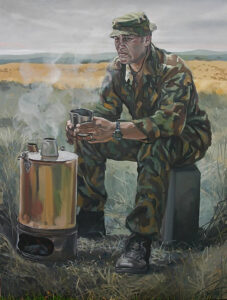 At the end of last month, Bob and I talked with Matt Gauldie about a commissioned painting we would like him to do for the RFCA. It will form part of the National Army Museum’s RF Cadet display which is targeted for opening in the middle of next year. (We will keep you posted on this as things progress.)
At the end of last month, Bob and I talked with Matt Gauldie about a commissioned painting we would like him to do for the RFCA. It will form part of the National Army Museum’s RF Cadet display which is targeted for opening in the middle of next year. (We will keep you posted on this as things progress.)
Matt is an ex New Zealand Army Artist. His website (which his painting to the left is from) describes his Army service as follows:
“Matt is most recognised for his official posting as New Zealand Army artist from 2004 to 2015. During this time, he produced paintings and sculptures depicting New Zealand soldiers on active operations overseas and throughout New Zealand. As part of this role, he was deployed to various countries such as Afghanistan, East Timor and Solomon Islands. He also travelled with New Zealand government contingents to historical war sites in Egypt, Turkey, France and Belgium. The works produced during these years were curated into a major exhibition, ‘Within the Ranks’, held at Canterbury Museum.”
Take a look at Matt’s work on his website.
Answers to August’s Cadet Class Trivia Questions
- How many Class Patrons were VC holders and what are their names? Ans: Four – Andrew, Ngarimu, Upham, Elliott
- How many sets of Classes have the same name and which are they? Ans: Four – Williams (1952, 1991), Weir (1958, 1969), Burrows (1974, 1990), Taylor (1987, 1989)
- Which Class Patron was the first Sergeant Major of the Army, in what Class did he join Cadets, and for what year was he Class Patron? Ans: WOI L.M. (Rusty) Taylor, MBE, BEM; Miles Class (1948); 1989
Award yourself a chocolate Dickson Crest if you got all those correct.